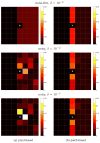Penalized likelihood PET image reconstruction using patch-based edge-preserving regularization
- PMID: 22875244
- PMCID: PMC4080915
- DOI: 10.1109/TMI.2012.2211378
Penalized likelihood PET image reconstruction using patch-based edge-preserving regularization
Abstract
Iterative image reconstruction for positron emission tomography (PET) can improve image quality by using spatial regularization that penalizes image intensity difference between neighboring pixels. The most commonly used quadratic penalty often oversmoothes edges and fine features in reconstructed images. Nonquadratic penalties can preserve edges but often introduce piece-wise constant blocky artifacts and the results are also sensitive to the hyper-parameter that controls the shape of the penalty function. This paper presents a patch-based regularization for iterative image reconstruction that uses neighborhood patches instead of individual pixels in computing the nonquadratic penalty. The new regularization is more robust than the conventional pixel-based regularization in differentiating sharp edges from random fluctuations due to noise. An optimization transfer algorithm is developed for the penalized maximum likelihood estimation. Each iteration of the algorithm can be implemented in three simple steps: an EM-like image update, an image smoothing and a pixel-by-pixel image fusion. Computer simulations show that the proposed patch-based regularization can achieve higher contrast recovery for small objects without increasing background variation compared with the quadratic regularization. The reconstruction is also more robust to the hyper-parameter than conventional pixel-based nonquadratic regularizations. The proposed regularization method has been applied to real 3-D PET data.
Figures












References
-
- Qi J, Leahy RM. Iterative reconstruction techniques in emission computed tomography. Physics in Medicine and Biology. 2006;51(15):R541–578. - PubMed
-
- Buades A, Coll B, Morel JM. Technical Report. Vol. 22. CMLA; 2006. Image enhancement by non-local reverse heat equation.
-
- Gilboa G, Osher S. Nonlocal linear image regularization and supervised segmentation. SIAM Multiscale Modeling and Simulation. 2007;6(2):595–630.
-
- Gilboa G, Osher S. Nonlocal operators with applications to image processing. SIAM Multiscale Modeling and Simulation. 2008;7(3):1005–1028.
-
- Kindermann S, Osher S, Jones P. Deblurring and denoising of images by nonlocal functionals. SIAM Multiscale Modeling and Simulation. 2005;4(4):1091–1115.
Publication types
MeSH terms
Grants and funding
LinkOut - more resources
Full Text Sources
Other Literature Sources

